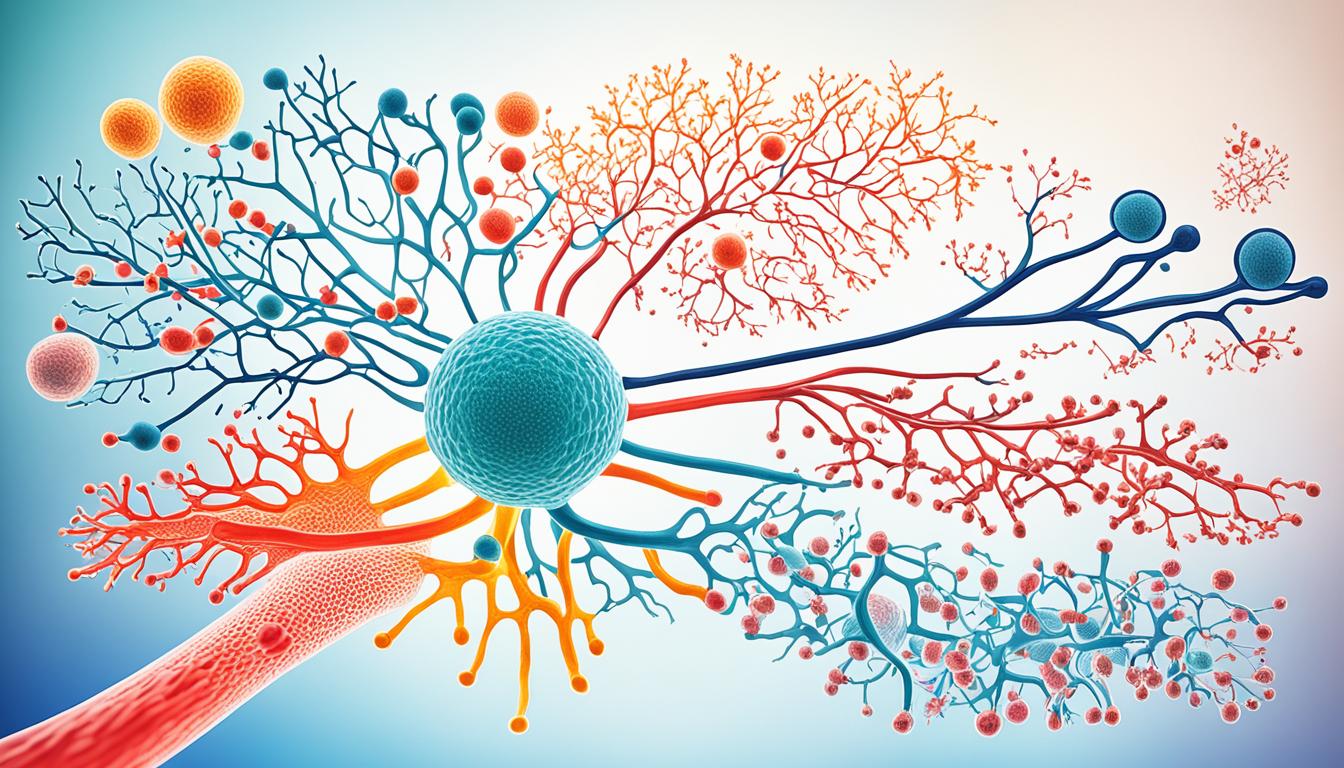Congenital adrenal hyperplasia (CAH) is a genetic condition. It affects the adrenal glands, leading to hormone imbalances. These imbalances come from a gene mutation, which lowers hormone production. This can cause problems with how a person’s primary or secondary sex features develop.
Doctors usually find CAH in kids’ hormone doctors. It’s key to catch it early. Newborns are checked for high 17-hydroxyprogesterone (17-OHP) to see if they have CAH. This blood test checks for a specific marker.
Treating CAH involves replacing the missing hormones with steroids. This helps balance the body and symptom manage. Steroids, like glucocorticoids, make up for what’s not there. If salt loss and electrolyte problems happen, other steroids might be needed.
Stem cell treatments are becoming an option for CAH. But, more studies are needed to know if they really help. The idea is that stem cells could offer a lasting fix for people with CAH.
Key Takeaways:
- CAH is a genetic issue that changes hormone levels.
- It often leads to low cortisol and problems in how sex features grow.
- Newborns are screened to start treatment early. Steroids are the main treatment.
- Treating with steroids helps balance hormones and ease symptoms.
- Stem cell therapy might be a future option but needs more study.
Etiology and Epidemiology of Congenital Adrenal Hyperplasia
Congenital adrenal hyperplasia (CAH) stems from issues in the CYP21A gene. These issues cause 21-hydroxylase deficiency, impacting the making of key hormones in the adrenal gland. This includes cortisol, aldosterone, and adrenal androgens.
The problem is that the CYP21A gene can’t make enough cortisol in the adrenal cortex. So, the body produces more adrenal androgens, like testosterone. This causes a hormonal imbalance. How severe the CAH is, depends on the mutation type.
CAH is not that uncommon. It affects about 1 in 60 people. But, the numbers can change based on where you look and the groups you study.
In the U.S., Native Americans and Yupik Eskimos have a higher chance of having CAH. For Whites, the chance is about 1 in 15,000. This shows that some populations might be more likely to have CAH. So, looking at a person’s background is key in diagnosing and treating CAH.
Prevalence by Ethnicity
CAH numbers differ among races. For instance, Native Americans and Yupik Eskimos face more risk. This tells us how important it is to understand these differences for the best care.
| Ethnicity | Prevalence (Approximate) |
|---|---|
| Native Americans | Higher incidence compared to general population (1 in 15,000) |
| Yupik Eskimos | Higher incidence compared to general population (1 in 15,000) |
| Whites | Lower incidence compared to Native Americans (1 in 60) |
These differences show how genes and environment affect CAH. They also point to the need for spot-on screening and care programs. This is to find CAH early and treat it well.
Pathophysiology and Diagnosis of Congenital Adrenal Hyperplasia
Congenital adrenal hyperplasia (CAH) is a genetic disorder. It’s characterized by issues in making steroids. This leads to making too many adrenal androgens.
This happens because some enzymes can’t change cholesterol into cortisol and aldosterone.
The main enzyme problem in CAH is called 17-hydroxylase deficiency. This issue makes it hard to produce cortisol, aldosterone, and adrenal androgens. This leads to a mix-up in hormones in those affected.
Doctors can often find CAH by checking the level of a substance called 17-hydroxyprogesterone (17-OHP) in the blood. High levels of 17-OHP are usually a strong sign of CAH.
Diagnosis and Neonatal Screening
Diagnosing CAH early is very important. It helps start the right treatment and avoid problems. So, babies are often checked for high 17-OHP levels right after birth.
Along with testing newborns, looking at their genes can help. It confirms what genetic issue they have. This helps choose the best way to treat them.
Key Points:
- CAH is characterized by impaired steroidogenesis and overproduction of adrenal androgens.
- Enzyme defects in the conversion of cholesterol to cortisol and aldosterone contribute to CAH.
- Elevated levels of 17-OHP are the most common diagnostic marker for CAH.
- Early diagnosis through neonatal screening and genetic analysis is essential for effective management of CAH.
Treatment and Management of Congenital Adrenal Hyperplasia
The main treatment for congenital adrenal hyperplasia (CAH) is to replace missing hormones. It also deals with the symptoms. Glucocorticoids, which are artificial, replace the missing natural adrenal hormones like cortisol. By doing this, it controls hormonal levels and lowers the symptoms.
For people with CAH who suffer from salt-wasting and problems with electrolytes, they might need mineralocorticoids too. This kind of therapy keeps the water and mineral balance right. It stops dehydration and other issues.
If adrenal glands make too many male hormones (androgens), androgen suppression therapy can help. This treatment aims to lower the effects of too much male hormone. It might help them feel better overall.
Stem cell therapy is becoming an exciting new area in treating CAH. It could fix or replace the broken adrenal parts, targeting the main issue. Yet, this method needs more studies to confirm how well and safe it is.

